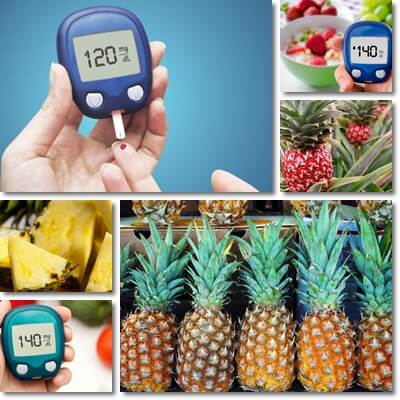Can diabetics eat pineapple? Yes, a diabetic can eat fresh pineapple, but in very limited amounts. Pineapple has an estimated of 10 g of sugar for every 100 g, but a moderate glycemic index meaning it will raise blood sugar levels somewhat fast. This makes it important for anyone with diabetes type 2 and type 1 to consume very small amounts of the fruit, preferably infrequently and spread their intake over the course of an entire day so as to maintain healthy blood sugar levels and prevent spikes. Eating the fruit with low glycemic foods or, even better, a lean protein meal, further slows down the absorption of the sugar in it, contributing to better blood sugar control and making it safer for diabetics to eat it.
It’s important to understand that pineapple doesn’t make blood sugar low. No fruit makes blood sugar low. Fruits contain simple sugars and carbohydrates that are also broken down into sugar so they will raise blood sugar levels. Pineapple carbs and sugar content and moderate glycemic index are the main reasons why it’s seen as bad for diabetics and not recommended in a diabetic diet. However, eating small amounts, no more than one serving a day, spreading your intake over the course of a whole day and combining foods wisely can make it safe to eat pineapple with diabetes.

Carbs in fresh pineapple: 13-13.5 g of carbohydrates/100 g of fresh fruit.
1 cup of pineapple chunks (estimated at 165 g) has 19.5-22 g of carbohydrates.
Carbohydrates in fruit and other food sources are an important energy source. Following digestion, carbohydrates are broken down into sugar and contribute to blood sugar levels. Because of their contribution to blood sugar levels, carbohydrates must be consumed in limited amounts in a diabetic diet. Because it’s an important source of carbohydrates, it is safe to eat pineapple only in very small amounts if you have type 1 or type 2 diabetes.
Sugar in pineapple: 10 g of sugar/100 g of fruit. Less sweet varieties may have as little as 8.3 g of sugar/100 g.
1 cup of pineapple chunks (estimated at 165 g): 16-17 g of sugar. Less sweet varieties may have as little as 14 g of sugar per cup.
Although it has less carbs and sugar than cherries and grapes, both of which are allowed in limited amounts in a diabetic diet, it’s still not a better fruit to eat for diabetes. See Can You Eat Grapes With Diabetes?
This is because the sugar in pineapple is absorbed faster into the bloodstream, resulting in a faster rise in blood sugar levels, which is bad for diabetes. It’s also why doctors and dietitians recommend caution when choosing this particular fruit to eat and remind people to eat very limited amounts, no more than one serving a day, preferably spread throughout the entire day. Avoid eating pineapple with other fruit and absolutely avoid the canned fruit, especially if it’s canned in syrup or sweetened juice. Also avoid the juice and dried, candied or frozen preparations, all of which often pack plenty of sugar.

Diabetes and pineapple glycemic index
If you are diabetic or trying to monitor your blood sugar levels and prevent spikes, then the glycemic index of foods is a great reference point for you. The glycemic index (GI) is a scale that measures how fast the carbs and sugars in a food are absorbed into the bloodstream and how much this will raise blood sugar numbers. The faster the absorption, the higher the rise in blood sugar levels.
0-55 is a low glycemic index (GI). 55-69 is a moderate GI. 70-100 is a high GI.
Pineapple glycemic index is 66, which is a moderate GI. So if you have diabetes, you need to limit your intake of this fruit because it has the potential to raise blood sugar levels too much too fast. With diabetes, even small amounts such as 150 g of some fruit can cause spikes in blood sugar levels for some people, hence the need for caution. Diabetics are generally advised to choose fruits with a low glycemic index, such as cherries (GI 22). See Can You Eat Cherries With Diabetes?
If you do want to eat pineapple, then you need to consider how to introduce it into your diet safely.
How to eat pineapple safely with type 2 diabetes and type 1 diabetes
1) Eat very small amounts, of the likes of 100 g per serving, preferably no more than 1 serving a day. Even better, see your doctor or a dietitian with experience in diabetes nutrition and diabetic diets to find out just how much you can eat safely with your condition.
2) Count your carbs and sugar. Plan ahead for eating pineapple. Count your sugar and total carbohydrates intake in a day and determine if you can introduce a small serving of pineapple too.
3) Never eat fruit with other fruit. With diabetes, it’s best to eat one fruit at a time (and in very small amounts). If you eat more than one fruit at a time, chances are you will not be able to determine the right serving size of each fruit and risk getting too much sugar and carbs and experience spikes in blood sugar levels as a result.
4) Better to avoid eating pineapple on an empty stomach. Having some other food, either a low-carb meal or a meal consisting of lean protein, will help temper the absorption of sugar and carbohydrates in the fruit and raise blood sugar levels more steadily.
5) Ideally, spread your intake of pineapple (or other fruit) over the course of an entire day. Even if it’s very little fruit. This helps to prevent rapid rises in blood sugar levels and helps you better keep to your low-carb, low-sugar diet.
6) If you are diabetic and are considering introducing pineapple into your diet, then choose the fresh fruit. Avoid pineapple juice and especially the dried, candied fruit, jams, juice mixes or other sweets containing the fruit.
Diabetes and pineapple overview
Eating pineapple with diabetes is not for everyone. Some diabetics may have a good tolerance of the fruit and be able to eat small amounts every now and then, while others may have a very low tolerance and be better off not eating the fruit at all. If you are not getting any benefits, experience side effects or just don’t feel good after eating the fruit, then maybe it’s time you eliminate it from your diet and look for other options that are better for you.
In general, when it comes to eating for good health, there isn’t a simple approach on things. Most foods will have both nutrients and anti-nutrients, or elements that are not as good for us, as well as different effects on people. What this means is that, depending on the person, their individual nutritional requirements, sensitivities or intolerance to various foods, existing medical conditions and their specifics, the same food may be bad for some, but good for others.
How is pineapple good for diabetes?
While pineapple is not one of the best fruits for diabetes type 2, at least not as good as cherries, for example, it’s not a fruit that must absolutely be avoided either. If you can tolerate it well enough to include it in your diet, then you may enjoy some benefits too.
1) 100 g of the fresh fruit has only 45-50 kcal, which is a low energetic value. This can bring benefits of the likes of helping with weight management and even contributing to weight loss where it’s needed.
2) The fruit is an important source of vitamin C, providing about 47.8 mg of vitamin C per 100 g. Vitamin C has regenerative effects, helping produce collagen for wound healing, a major concern for diabetics.
3) Furthermore, the fruit is a good source of vitamin B6 (0.112 mg) as well as contains small amounts of potassium and magnesium, three nutrients with a protective action on the cardiovascular system and blood pressure-lowering properties. Considering high blood pressure and other cardiovascular problems are leading complications of diabetes, these nutrients are worth introducing into a diabetic diet.
4) Lastly, the fruit is a good source of vitamin B1 and contains smaller amounts of vitamins B2, B3, B5, B9 and choline, contributing to nervous system health and possible benefits for the nerve damage associated with type 1 and type 2 diabetes.
But does pineapple make blood sugar low?
No, it doesn’t. And this is one of the most important things to remember. Pineapple actually raises blood sugar levels because it’s a fruit and it contains sugar. How much of it you eat will determine how much and how fast your blood sugar levels will rise and whether there will be benefits or side effects for your condition. But remember that pineapple doesn’t prevent or cure blood sugar spikes and it’s certainly not some magic cure for diabetes.
Conclusion
Many healthcare professionals consider pineapple is not one of the best fruits for diabetics diets, whether it’s diabetes type 2 or type 1. The truth is the fruit is both good and bad for diabetics, depending how you eat it and how much of it you eat. Many people just find it difficult to limit their intake and end up eating too much too often, causing an unhealthy rise in blood sugar levels. Whereas pineapple is merely tolerated in a diabetic diet, if and only if it’s consumed in limited, meaning very small amounts that do no exceed individual nutritional requirements.
